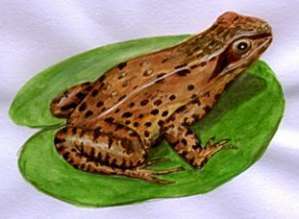Frogs
 The frog you are most likely to see in Britain is the common frog (Rana temporaria), which lives on land in damp habitats for most of the year. It may be found in open woods, hedgerows, fields and gardens, not too far from water. The body colour varies widely, with upper parts usually brown or olive, but sometimes yellowish- orange or grey. The underside is normally paler, and the whole body is blotched or spotted with a darker colour, which helps to camouflage it against its background. This frog has a distinctive dark patch behind its eye. A male common frog is slightly smaller than the female, which measures about 7.5cm (3in.).
The frog you are most likely to see in Britain is the common frog (Rana temporaria), which lives on land in damp habitats for most of the year. It may be found in open woods, hedgerows, fields and gardens, not too far from water. The body colour varies widely, with upper parts usually brown or olive, but sometimes yellowish- orange or grey. The underside is normally paler, and the whole body is blotched or spotted with a darker colour, which helps to camouflage it against its background. This frog has a distinctive dark patch behind its eye. A male common frog is slightly smaller than the female, which measures about 7.5cm (3in.).
Frogs move by hopping or leaping, using their long, muscular back legs; they do not crawl. They have very smooth, damp skins. The fully-webbed hind feet help them to swim.
Diet: Frogs eat insects and other invertebrates, such as slugs, snails and worms. On summer days, they like to hide amongst tall plants and come out on warm, damp evenings to hunt. Like all amphibians, it is hard for them to find food during the winter, and they cannot function in cold temperatures, so from about mid-October they hibernate in a sheltered place on land e.g. under a log, or in the muddy bottoms of ponds. Males often hibernate in the bottom of ponds, so that they are already at the breeding site when the females arrive in the early spring. They can take in sufficient oxygen through their skin during hibernation under the water.
Breeding: A frog is ready to breed at about two years old. After their winter hibernation, frogs emerge to migrate to breeding ponds, returning, if possible, to the places where they themselves were hatched. The males usually arrive first, usually in February or March, but often January in the south-west of England and begin croaking loudly to attract the females. The male frog develops thick pads of rough skin on his thumbs, which enable him to grip the slippery female firmly whilst mating. The female releases about 2,000 eggs into the shallow parts of the pond, and, as they leave her body, the male releases his sperm over them. The jelly around each egg swells up, so protecting the egg and helping to keep it warm. The spawn sinks to begin with, but soon swells and rises to the surface. After spawning, the adults usually stay in the water until April, when the weather is warmer, and then live on the land.
Tadpoles hatch from the eggs after about two weeks. It will be three months before they will have developed into tiny miniature frogs, ready to leave the pond. As they leave the water, they are very vulnerable to predators such as blackbirds. At any age they may be eaten by grass snakes, cats, crows, herons, ducks, hedgehogs, rats and foxes.
The only other native species of frog in Britain i.e one that has been in this country for thousands of years, is the pool frog (Rana lessonae). Until a few years ago, it was thought that the small population of pool frogs found only in Norfolk, had been introduced from the Continent in the 1800s. However, when an archaeologist examined small bones from excavations in the area, he dated the pool frog in Britain back to the Bronze Age and Saxon times. It seems that the pool frog had been with us, unnoticed, for all those years! Later, in the 1990s they were considered extinct for some time until a colony was found in East Anglia. Pool frogs are extremely rare, they are protected under law which means it is illegal to kill them. In 2005 pool frogs brought over from Sweden were reintroduced to the wild in a nature reserve in Norfolk and they have since been discovered at other sites in Essex, Hampshire and Surrey.
Pool frogs belong to a group of frogs known as "green frogs", and both the marsh frog (Rana ridibunda) and the edible frog (Rana esculenta) belong to this group too. They are native to much of Europe, but not Britain. The edible frog was introduced to Britain in the 1800s, is slightly bigger than the common frog and bright green in colour. There are a few scattered colonies in the south-east and East Anglia. As their name suggests, edible frogs (or at least their legs) can be cooked and eaten.
The marsh frog was introduced to Britain from Hungary in 1937. It was released into Romney Marsh in Kent and quickly spread to adjoining areas of Kent and Sussex. It is bigger than the common frog, up to about 12.5cm (5in). has a more pointed snout and its eyes are closer together, without the dark patch behind them. They spend a lot of their time in water and breed in late May or early June.
In recent years, several "alien" frogs, including the marsh frog and a much bigger bullfrog from America, have been sold in pet shops and garden centres for garden ponds. In some areas, several of these have escaped and have adapted well to their new habitats. Unfortunately, they are inclined to eat the young of our common frog, and may pose a threat to its future.
Read More: Toads